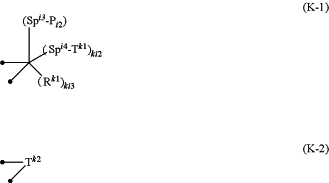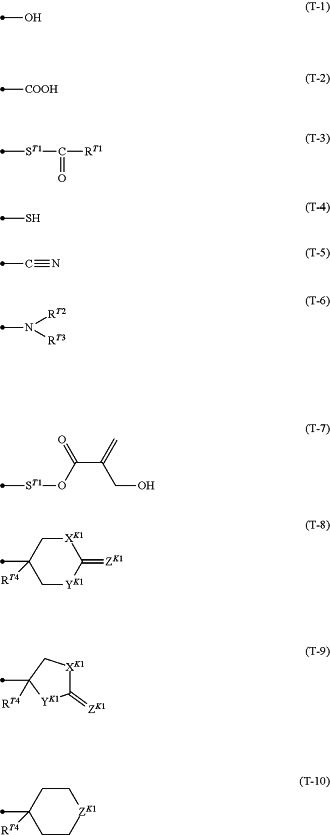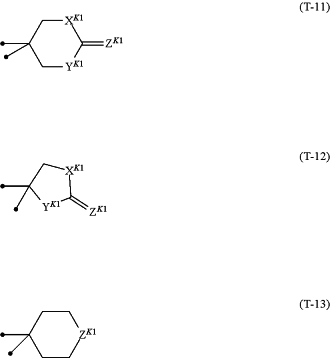| CPC C09K 19/3405 (2013.01) [C09K 19/12 (2013.01); C09K 19/2028 (2013.01); C09K 19/32 (2013.01); C09K 2019/122 (2013.01); C09K 2019/123 (2013.01)] | 14 Claims |
|
1. A liquid crystal composition comprising at least one compound A and at least one compound C, wherein the at least one compound A is represented by general formula (Y) below, and the at least one compound C is represented by general formula (II) below,
 in general formula (Y),
Sy1 and Sy2 each independently represent a single bond, a linear C1 to C12 alkylene group or a branched C2 to C12 alkylene group, optionally with a hydrogen atom or hydrogen atoms in the alkylene group substituted by a halogen atom, a cyano group, or a nitro group, optionally with a —CH2— or —CH2-s in the alkylene group substituted with —CH═CH—, —C≡C—, —CO—, —COO—, —OCO—, —OCOO—, —O—, —NH—, or —S—, although without two or more —O-s consecutively next to each other,
My1, My2, and My3 each independently represent a divalent aromatic group, a divalent alicyclic group, a divalent heterocyclic compound group, a divalent fused-ring system, or a divalent fused-polycyclic system, optionally with a hydrogen atom or hydrogen atoms in the ring structure substituted with Ly1,
Ly1 represents Py3—Sy3—, a halogen atom, a cyano group, a nitro group, a linear C1 to C30 alkyl group or a branched C3 to C30 alkyl group, optionally with a hydrogen atom or hydrogen atoms in the alkyl group substituted by a halogen atom, a cyano group, or a nitro group, optionally with a —CH2— or —CH2-s in the alkyl group substituted with —CH═CH—, —C≡C—, —CO—, —COO—, —OCO—, —OCOO—, —O—, —NH—, or —S—, although without two or more —O-s consecutively next to each other, and if there are a plurality of Ly1s, the Ly1s may be the same or different,
Py1, Py2, and Py3 represent polymerizable groups,
Sy3 represents a single bond, a linear C1 to C12 alkylene group or a branched C2 to C12 alkylene group, optionally with a hydrogen atom or hydrogen atoms in the alkylene group substituted by a halogen atom, a cyano group, or a nitro group, optionally with a —CH2— or —CH2-s in the alkylene group substituted with —CH═CH—, —C≡C—, —CO—, —COO—, —OCO—, —OCOO—, —O—, —NH—, or —S—, although without two or more —O-s consecutively next to each other,
Zy1 and Zy2 each independently represent a single bond, —C2H4—, —C4H8—, —C3H6—, —OCH2—, —CH2O—, —CO—, —COO—, —OCO—, —OCOOCH2—, —CH2OCOO—, —OCH2CH2O—, —CH═CRa—COO—, —CH═CRa—OCO—, —COO—CRa═CH—, —OCO—CRa═CH—, —COO—CRa═CH—COO—, —COO—CRa═CH—OCO—, —OCO—CRa═CH—COO—, —OCO—CRa50 CH—OCO—, —COOC2H4—, —OCOC2H4—, —C2H4OCO—, —CH2OCO—, —COOCH2—, —OCOCH2—, —CH═CH—, —CF═CF—, —CF═CH—, —CH═CF—, —CF2O—, —OCF2—, —CF2CH2—, —CH2CF2—, —CF2CF2—, or —C≡C—, in the formulae, Ra at each occurrence independently represents a hydrogen atom or a C1 to C4 alkyl group,
m and n each independently represent an integer of 0 to 4, with the proviso that m+n is 0 to 6, and
if Sy1, Sy2, or Ly1 is a C1 to C12 alkylene or alkyl group, one or more —CH2-s therein are substituted with a substructure represented by general formula (A-1) below
—Sy4—Ki1—Sy5— (A-1)
in general formula (A-1), Sy4 and Sy5 each independently represent a single bond, a C1 to C12 linear alkylene group or a branched C2 to C12 alkylene group, optionally with a hydrogen atom or hydrogen atoms in the alkylene group substituted by a halogen atom, a cyano group, or a nitro group, optionally with a —CH2— or —CH2-s in the alkylene group substituted with —CH═CH—, —C≡C—, —CO—, —COO—, —OCO—, —OCOO—, —O—, —NH—, or —S—, although without two or more —O-s consecutively next to each other, and
Ki1 at each occurrence independently represents a group represented by general formula (K-1) or (K-2) below
 in general formula (K-1),
Spi3 and Spi4 each independently represent a single bond, a linear C1 to C20 alkylene group, a branched C2 to C20 alkylene group, a linear C1 to C20 halogenated alkylene group or a branched C2 to C20 halogenated alkylene group, optionally with a —CH2— or —CH2-s in the alkylene or halogenated alkylene group substituted with —CH═CH—, —C≡C—, or —O— without two —O-s consecutively next to each other,
Pi2 represents a polymerizable group,
Rk1 at each occurrence independently represents a hydrogen atom, a linear C1 to C6 alkyl group or a branched C3 to C6 alkyl group, optionally with one —CH2— in the alkyl group, or nonadjacent two or more —CH2-s in the alkyl group, substituted with —O—,
ki1 and ki3 each independently represent 0 or 1, and ki2 represents 1 or 2, with the proviso that ki1+ki2+ki3 is 2, and
Tk1 at each occurrence independently represents a group represented by any of general formulae (T-1) to (T-10)
 in general formulae (T-1) to (T-10), ST1 at each occurrence independently represents a single bond, a linear C1 to C15 alkylene group, a branched C2 to C15 alkylene group, a linear C2 to C18 alkenylene group or a branched C3 to C18 alkenylene group, optionally with a —CH2— or —CH2-s in the alkylene or alkenylene group substituted by —O—, —COO—, —C(═O)—, or —OCO— unless oxygen atoms come consecutively next to each other,
RT1 at each occurrence independently represents a C1 to C5 alkyl group, optionally with a —CH2— or —CH2-s in the alkyl group substituted by —O—, —COO—, —C(═O)—, or —OCO— in such a manner that oxygen atoms are not consecutively next to each other, and
RT2, RT3, and RT4 each independently represent a hydrogen atom or a C1 to C12 alkyl group, optionally with a —CH2— or —CH2-s in the alkyl group substituted by —O—, —COO—, —C(═O)—, or —OCO— unless oxygen atoms come consecutively next to each other, and
in general formula (K-2), Tk2 at each occurrence independently represents a group represented by any of general formulae (T-11) to (T-13)
 in general formulae (T-11) to (T-13), XK1 and YK1 each independently represent —CH2—, an oxygen atom, or a sulfur atom, and
ZK1 at each occurrence independently represents an oxygen atom or a sulfur atom, the black dots in the formulae represent bonds, or one or more hydrogen atoms in Sy1, Sy2 My1, My2, My3, or Ly1 are substituted with a substructure represented by general formula (A-2) below
 in general formula (A-2), Sy6 represents a single bond, a linear C1 to C12 alkylene group or a branched C2 to C12 alkylene group, optionally with a hydrogen atom or hydrogen atoms in the alkylene group substituted by a halogen atom, a cyano group, or a nitro group, optionally with a —CH2— or —CH2-s in the alkylene group substituted with —CH═CH—, —C≡C—, —CO—, —COO—, —OCO—, —OCOO—, —O—, —NH—, or —S—, although without two or more —O-s consecutively next to each other,
Tk3 represents a group represented by any of general formulae (T-1) to (T-13) and (T-14) to (T-24)
 in general formulae (T-14) to (T-24),
XK2 and YK2 each independently represent —CH2—, an oxygen atom, or a sulfur atom,
ZK2 at each occurrence independently represents an oxygen atom or a sulfur atom, and
UK2, VK2, and SK2 each independently represent a methine group or a nitrogen atom, the black dot in the formulae represents a bond, and ki4 is 1 to 3,
 in general formula (II), RII1 represents a C1 to C10 alkyl group or a C2 to C10 alkenyl group, optionally with one —CH2— in the alkyl group, or each of nonadjacent two or more —CH2-s in the alkyl group independently, substituted by —CH═CH—, —C≡C—, —O— —CO—, —COO—, or —OCO— unless oxygen atoms come consecutively next to each other,
RII2 represents a hydrogen atom, a halogen atom, a cyano group, a C1 to C10 alkyl group, or a C2 to C10 alkenyl group, optionally with one —CH2— in the alkyl group, or each of nonadjacent two or more —CH2-s in the alkyl group independently, substituted by —CH═CH—, —C≡C—, —O—, —CO—, —COO—, or —OCO— unless oxygen atoms come consecutively next to each other, optionally with one or two or more hydrogen atoms in the alkyl group substituted with a halogen atom,
with the proviso that at least one of RII1 or RII2 represents a C2 to C10 alkenyl group,
AII1 and AII2 each independently represent a group selected from the group consisting of:
(a) a 1,4-cyclohexylene group, one —CH2— or two or more nonadjacent —CH2—S present in the group may be replaced by —O— unless oxygen atoms come consecutively next to each other;
(b) a 1,4-phenylene group, one —CH═ or two or more nonadjacent —CH=s present in the group may be replaced by —N═; and
(c) a 2,6-naphthalenediyl, 1,2,3,4-tetrahydronaphthalene-2,6-diyl, or decahydronaphthalene-2,6-diyl group, one or two or more —CH=s present in the group may be replaced by —N═,
optionally with the groups (a), (b), and (c) each independently substituted with a cyano group or a halogen atom,
ZII1 represents a single bond, —CH2CH2—, —(CH2)4—, —OCH2—, —CH2O—, —COO—, —OCO—, —OCF2—, —CF2O—, —CH═N—N—CH—, —CH═CH—, —CF═CF—, or —C≡C—, and
mII1 represents 1, 2, 3, or 4, and if mII1 represents 2, 3, or 4, the plurality of AII1s may be identical or different, and the plurality of ZII1s may be identical or different,
in general formula (II), any compound represented by general formula (Y) or (P) is excluded.
|